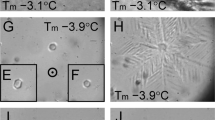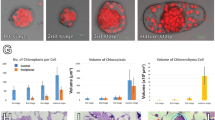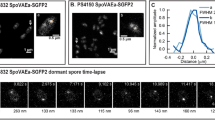Abstract
DURING an investigation of the ultrastructure and physiology of dormant plant embryos, it was thought of interest to examine the fine structure of embryos maintained in a dormant state for an abnormally long period by withholding the necessary stimulus for resumption of growth, in this particular case by chilling for a period at 5° C.
This is a preview of subscription content, access via your institution
Access options
Subscribe to this journal
Receive 51 print issues and online access
$199.00 per year
only $3.90 per issue
Buy this article
- Purchase on Springer Link
- Instant access to full article PDF
Prices may be subject to local taxes which are calculated during checkout
Similar content being viewed by others
References
Villiers, T. A., and Wareing, P. F., J. Exp. Bot., 15, 359 (1964).
Hugon, J., and Borgers, M., Lab. Invest., 15, 1528 (1966).
Daniel, M. R., et al., J. Cell Biol., 30, 465 (1966).
Novikoff, A. B., and Essner, E., J. Cell Biol., 15, 140 (1962).
Ericsson, J. L., and Trump, B. F., Lab. Invest., 14, 1341 (1965).
Gomori, G., Microscopic Histochemistry (Chicago, 1952).
Author information
Authors and Affiliations
Rights and permissions
About this article
Cite this article
VILLIERS, T. Cytolysomes in Long-dormant Plant Embryo Cells. Nature 214, 1356–1357 (1967). https://doi.org/10.1038/2141356b0
Received:
Revised:
Issue Date:
DOI: https://doi.org/10.1038/2141356b0
This article is cited by
-
The endomembrane system of differentiating carposporangia in the red algaChondria tenuissima: Occurrence and participation in secretion of polysaccharidic and proteinaceous substances
Protoplasma (1985)
-
Disintegration of chloroplasts during zygote formation inSpirogyra verruculosa
The Botanical Magazine Tokyo (1982)
-
Acid phosphatase activity in plastids (plastolysomes) of senescing embryo-suspensor cells
Planta (1980)
-
The fine structural localization of p-Nitrophenyl phosphatase activity in the storage cells of pea (Pisum sativum L.) cotyledons
Protoplasma (1978)
-
Lysosomal Activities of the Vacuole in Damaged and Recovering Plant Cells
Nature New Biology (1971)
Comments
By submitting a comment you agree to abide by our Terms and Community Guidelines. If you find something abusive or that does not comply with our terms or guidelines please flag it as inappropriate.



